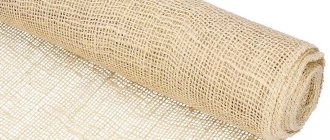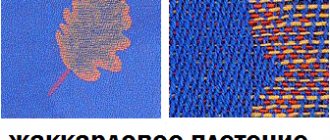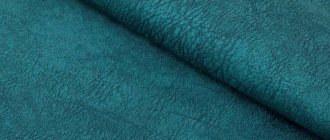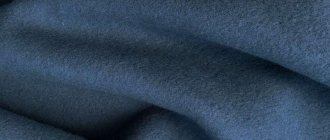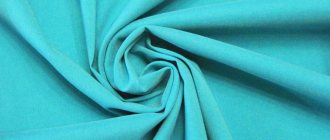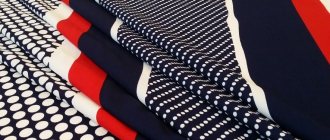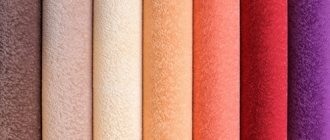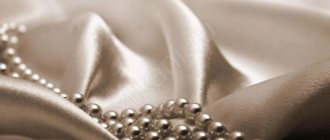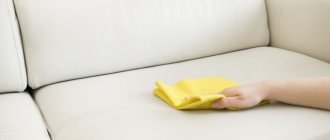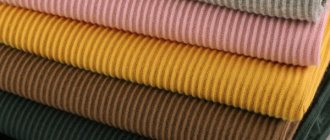Taffeta fabric is popular in the manufacture of workwear for fishermen and hunters, tourist tents, awnings, raincoats and off-season jackets for every day. The material is famous for its protective properties and durability. What kind of taffeta fabric is, what is it made from and what types exist - read in this article.
The name of taffeta fabric is very similar to the name of another taffeta fabric. Perhaps this is their only similarity, since taffeta looks much simpler and has a different composition from taffeta. The second name is polyester silk, because its characteristics are very similar to natural silk material.
History of appearance
Another name for taffeta fabric is special polyester silk. This name comes from the Persian concept of “taffeta,” which previously meant the finest silk fabric. The question of what is taffeta fabric is easy to answer; this fabric is budget-friendly and is used as an inner lining for clothes or bags. But real silk is too valuable and not suitable for such use. It turns out that taffeta is actually one of the types of synthetics that is universal and widely used for sewing products.
Type of matter
Description
Taffeta or polyester silk gets its name from the taffeta fabric, which is glossy and silky. The two materials share a similar appearance with a smooth surface and a silky sheen. Other than that, they have nothing in common. Taffeta is cheaper and not as beautiful as luxury taffeta.
Taffeta is a fabric with a glossy shine, airy and smooth, which is easy to see from the photo. It is thin and flowing. The synthetic fabric is made with simple weaving threads. Has little elasticity. The fabric can be plain-dyed in a wide range of colors or with a printed pattern. Camouflage patterns and jacquard are in demand.
The composition of the material is 100% polyester or 100% nylon with a protective coating.
Unique material properties
The common quality for almost any type of this synthetic textile is lightness, thinness and glossy flatness. In this case, the fabric is distinguished according to the composition of the fibers, the material for which is:
- Polyester;
- Nylon.
Polyester
The parameters of polyester and nylon have almost the same description with minor differences.
Nylon material has quite enviable resistance to water and resistance to chemicals, practically does not deteriorate when washed and worn for a long time, and is elastic to a certain extent.
Nylon
However, nylon still has disadvantages. For example, nylon is easily electrified and almost does not allow air to pass through, which can harm a person. At the same time, nylon has a special coating and therefore this type of fabric is convenient to use for the manufacture of raincoats, jackets, awnings, tents and, in some cases, equipment for tourists. Sometimes such fabric is used as lining material for bags and backpacks or clothing.
You might be interested in this: Differences between dublerin and non-woven fabric: which is better
Product made of material
Polyester is much inferior to nylon in 2 main parameters: reliability and resistance to chemicals. But at the same time, polyester fibers by their nature are highly resistant to temperatures and electromagnetic waves of ultraviolet radiation. As a result, any type has its pros and cons. And the choice remains with the person who decided to purchase several meters of matter for his own purposes.
Material Density
Density has a noticeable effect on the quality of the fabric. It is determined by the number of warp and weft threads per square inch of the plane, and this T value should be reflected in the description of the fabric. The density of this fabric varies from 160T to 240T. And the weight of this raw material does not depend at all on the density, but on the presence and method of impregnation. For lightweight fabrics intended for use as lining, the density is generally not indicated. Taffeta lining fabric can be translucent, mesh, and in some cases has a knitted base.
Fabric lining
Kinds
Lining taffeta
To impart specific properties to fabric, several types of impregnations are used. They are distinguished by markings.
- PU is a transparent film layer that gives the material water-repellent qualities. Applied from the inside or outside of the material.
- PU milky – cream-colored inner polyurethane coating. Gives the fabric moisture-proof properties.
- PVC is a protective layer of polyvinyl chloride that protects against overheating, getting wet and contact with chemicals.
- Silver – polymer silver layer. Down-holding impregnation that protects against moisture. It is the best option for insulated outerwear, camping tents and commercial canopies. Thanks to the reflective properties, the sun's rays do not penetrate through the fabric, and the air inside the tent does not heat up.
Jacquard taffeta
Mainly used as a lining, it is more dense. This material is quilted with padding polyester for lining coats or bedspreads. The strongest taffeta is produced under the “Rip Stop” marking, which indicates the additional use of especially strong fibers for the manufacture of fabric.
In many ways, the properties of new generation synthetics depend on the density of the fabric. It is indicated by a quantitative indicator and alphanumeric marking T (tex). Density varies from 170 to 230 T (Texture Element).
Technical characteristics: impregnation options
For fabrics with high density, special impregnations are mainly used:
- PVC - Poly Vinyl Chloride - is a special impregnation, the inner layer of which is equipped with absolute waterproofness, resistance to chemicals, and protection from elevated temperatures.
- PU milky is a type of pure white polyurethane interior coating;
- PU - colorless or transparent polyurethane, creates a layer that is resistant to water, in many cases applied from the inside out;
- Silver - a silver-colored coating that can protect from water elements and ultraviolet rays, in addition, it can hold a significant amount of fluff;
Use Cases
Ways to use taffeta fabric
The use of this type of material is universal, but depends on the strength, density and certain properties of the impregnation.
- Polyester, especially thin, is very inexpensive, and is often used as a disposable decorative material for a variety of decorations, ephemeral draperies, packaging, garlands and flags. Thin polyester and nylon are used for a variety of linings. One could argue that taffeta lining is a really useful material for hiding the back edge.
- High density fabric is used to make autumn jackets, long coats, winter jackets, fitness suits and women's trousers. The range of this material, colors and patterns on the outer surface vary greatly. The use of decorative coatings and varnish effect makes it possible to create budget-friendly, affordable and practical clothing. In addition, clothing made from high-density raw materials is quite impressive, and stores have a wide selection of jackets and suits made from special raw materials.
You might be interested in Features of the properties of taslan fabric and its use
Jacket
- Dense and reliable taffeta with special impregnations is used for the manufacture of a number of products: suits, awnings, special clothing, tents and tourist clothing. Further, demi-season and winter shoes, backpacks, umbrellas, and bags are produced from this type of material.
Cloth suit
Important! You need to be more careful when purchasing a product and evaluate the reliability and water resistance of the product.
Especially if there are many requirements for the production of this type of product.
Manufacturing technology
Taffeta is made from synthetic fibers by simply weaving threads. But the quality characteristics of such fabric are low, and the scope of application is limited. Several methods are used to improve performance:
- Additional reinforcement that enhances strength and density. Thickened threads are woven into the main fabric at regular intervals. This technology is called “Rip Stop”. The distance between additional fibers can vary in the range of 2-10 mm. This technique not only improves the quality of the canvas, but also changes the texture. A drawing appears on the surface. Its specificity depends on the chosen technique. When using regular RipStop, cells will form. Rombus RipStop makes it possible to get diamonds. And Honey RipStop is a complex pattern in the form of hexagons.
- Colanding. Technology that requires special equipment. A fabric obtained by simple weaving is passed through rollers heated to a certain temperature. This leads to a slight melting of the top layer, which increases wind- and down-proof properties and gives the fabric an elegant shine.
Nylon Taffeta 290T Cire is a sample of colanded fabric. This variety protects well from the wind, securely holds the filler, and is characterized by high elasticity and wear resistance.
What are the characteristics of taffeta fabric?
The properties of this fabric differ and depend primarily on the material used in the manufacture of goods: polyester or nylon. Airiness, lightness and a bit of shine are the same for both types of taffeta. They do not shrink in size when in contact with water and dry in a short time. Nylon can be worn for a very long time. The material is reliable, resistant to water and stretches easily.
Awning
Note! The taffeta is coated on the front side with a special layer of silver to protect the fabric from the harm of ultraviolet radiation and exposure to water.
When you want to purchase clothes or shoes made from a special material or pieces of this material, you need to carefully study the label for sewing. Usually the type of coating and the degree of density of the fabric are given there, because this significantly changes the quality of the fabric and the scope of use of the product. This special fabric is used in a wide variety of clothing, hiking backpacks, heavy-weather shoes, and even several types of tents.
Where is taffeta used?
Lightweight fabric without impregnation is in most cases used as a lining. The taffeta material is light, thin, drapes perfectly, and there are practically no hard seams. At the same time, it does not collect static electricity. There is a quality of removal of moisture that is released by the physical body, and a favorable microclimate is formed. This type of fabric does not cause allergies.
This type of fabric is easy to apply fashionable prints that remain for a long time. Light taffeta is used to hide the underside, while thick taffeta is used to give shape to clothes or shoes. Lining and thick fabric are equally important. After all, jackets and raincoats made of dense material are resistant to wind and water. And when there is insulation in the form of down and synthetic padding, the material easily retains heat.
You might be interested in Description of all types of synthetic fabrics
This fabric is used to make autumn jackets, down jackets, warm trousers and even overalls, boots and sneakers, waterproof backpacks, special suits and many other things. In addition, even posters, awnings, sleeping bags, streamers and banners are made from this type of raw material.
What kind of suits are made from taffeta?
- fishing;
- skiing;
- hunting;
- sports;
- overalls.
Note! The taffeta is coated on the front side with a special layer of silver to protect the fabric from the harm of ultraviolet radiation and exposure to water.
Insulation:
Termotex (Termo-tex).
A hollow fiber, a single component of which in space has the appearance of a spiral spring. These individual components, intertwined with each other, form a strong springy structure. This property allows the fiber, unlike other materials such as padding polyester, batting, etc., to quickly restore its shape after being crushed, and is highly resistant to maintaining its shape over time. Thermotex provides unique properties of thermoregulation, preservation of “internal” heat with the ability of the body to “breathe”, has anti-allergenic properties, and does not absorb foreign odors. Easy to wash.
Sintepon.
Non-woven material made from polyester fibers by a thermal method, which has such properties as elasticity, lightness, elasticity, strength and softness. Synthetic winterizer retains heat perfectly due to its low thermal conductivity and does not lose it for a long time and easily restores its original shape after washing. The padding polyester is lightweight, adds volume to the product, is completely non-toxic and does not pose any harm to human health.
Thinsulate.
The high thermal insulation properties of Thinsulate are based on the use of hollow microfibers. It is currently considered one of the best insulation materials; its heat-saving properties are equal to down. Excellent heat retention. Thinsulate clothing is light, thin, warm and breathable. Does not deform when washed.
Ecoloft.
Made from recycled fiber and warmer than others. The highly compressed soft material allows the efficient use of the resources provided by nature with minimal harmful impact on the environment. Silver-based antibacterial impregnation prevents the spread of bacteria and the unpleasant odors they cause.
How to properly care
How to properly care for taffeta? This synthetic fabric is unpretentious and the material is actually easy to care for:
- Any type of this material, with a special coating or not, tolerates many washes in a washing machine at a temperature of 45 degrees.
- But it’s better not to dry it in a machine. This fabric dries quite quickly and it is better not to use an iron, but if necessary, the fabric can be ironed at temperatures up to 100 degrees.
- It is best to avoid dry cleaning and not allow chlorine to come into contact with the fabric.
On a note! The price range of the fabric is really diverse and 1 meter of fabric can be bought from 25 rubles and more, depending on the density of the material and also the influence of several characteristics. Overalls made from a special material cost on average 1,500 rubles, and if the quality is better, then from 2,000 rubles and more.
Proper care
Thanks to production technology, synthetic taffeta can be easily cleaned from dirt. To maintain the original properties, it is recommended to follow simple rules:
- Suitable for machine wash. Withstands all modes. The main condition is to set the temperature no higher than 45°;
- dry naturally by hanging on a clothesline;
- no ironing required. Wrinkle-resistant fabric does not require heat treatment. If ironing is unavoidable, use damp gauze on the reverse side. This will prevent the sole of the iron from sticking to the surface;
- Avoid chlorine-containing cleaners. An aggressive environment negatively affects color and destroys the fiber structure.
Recommendation! You shouldn't store dirty things. The longer the dirt remains, the more difficult it is to remove. Remove stains immediately after they appear.
Advantages and disadvantages
This polyester material is more abrasion resistant than nylon and is more resistant to ultraviolet radiation and elevated temperatures. The main disadvantages of this type of product are increased electrification, low conductivity of air and water vapor. When special impregnation is used, the material loses its lightness, but at the same time acquires important qualities:
- a colorless polyurethane coating (called PU) is applied on the inside to make it resistant to water;
- white polyurethane (PUmilky) is used to compensate for the internal flatness, in order to make the material resistant to water and colored, in addition to making the color more saturated.
Whether it is worth purchasing taffeta and using it for your own purposes is a matter and choice of each person individually. The main thing is to understand what really matters when choosing fabric. And one undeniable fact about canvas is that the fabric is useful and protects from rain. It also keeps you warm in winter, keeping the warmth inside the down jacket.
